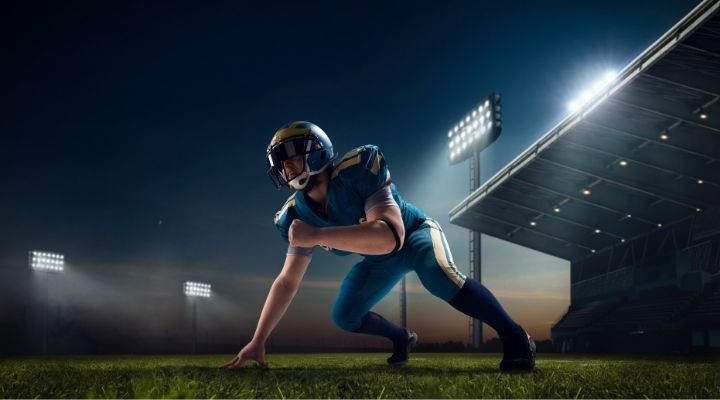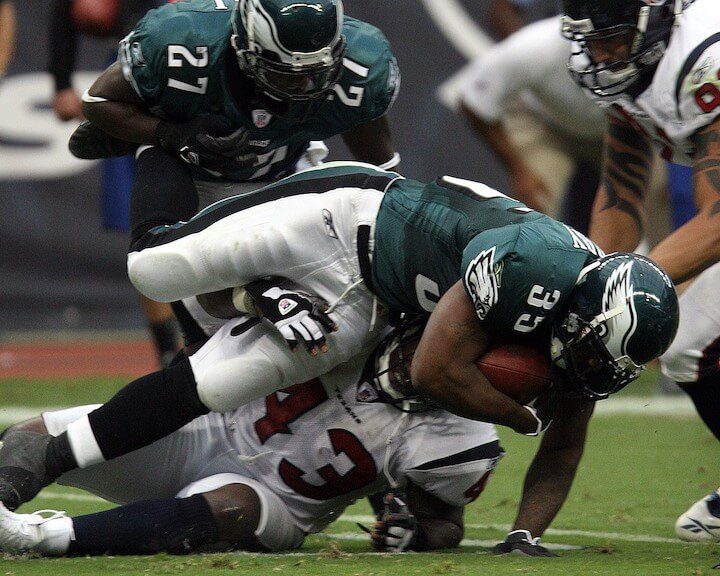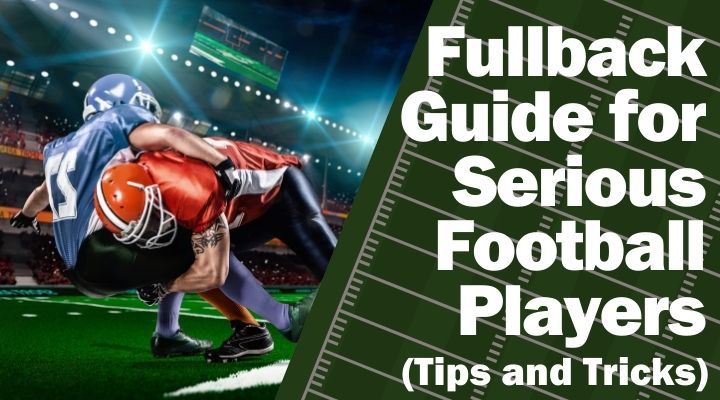The fullback used to be a prominent feature of all offenses in football.
Playing out of the offense’s backfield, teams used to deploy fullbacks a lot – especially when the game, back then, was more ‘ground and pound’.
These bruising backs mainly served as lead blockers when the offense would choose to run the ball.
However, the fullback in today’s game has sort of gone by the wayside due to the increasing tendency of offenses to throw the ball in a fast-paced attack.
Especially at the collegiate and professional levels of the game, teams have opted to replace the traditional fullback for an extra wide receiver or tight end.
Even teams that do run the football a lot tend to run out of spread formations that force the defense to cover more of the field side to side.
But, the fullback position isn't completely gone just yet.
In youth football - where teams opt to run the ball more - the fullback is still an extremely important position.
Let’s take a closer look at the fullback position in football.

What is a Fullback in Football?
Fullback is a challenging position to play because players must be able to do many different things.
Their main job is to serve as the lead blocker on running plays to help the ball carrier get through defenders for a huge gain.
Although this is their main priority, they may also end up occasionally running the ball themselves or catching passes out of the backfield.
To do all these, they’ll need to be a mix of an offensive lineman, a tight end, and a running back -- all wrapped up into one.
Fullback Position on the Field
Fullbacks start each play in the backfield together with the quarterback and a running back.
More often than not, the fullback lines up somewhere between the quarterback and the running back.
When the QB lines up under center, the fullback lines up behind him – either directly behind or to either side. This position enables him to get in between the ball carrier and the rushing defenders.
However, some plays and formations will have the both fullback and running back split the backfield – one on each side behind the QB.
No matter where the fullback starts, he’ll need to be ready to lead the running back to openings, help protect the quarterback from rushing defenders, or run a route before receiving the pass.
What does a Fullback Do?
1. Identify the Correct Player to Block
A fullback's main role is as a lead blocker for running backs and quarterbacks in the running game.
Unlike an offensive lineman, though, a fullback won't necessarily have a distinct blocking assignment on every play.
Instead, he’ll be asked to run through a particular gap along the line of scrimmage and then pick up whatever defender breaks free and comes his way first.
Again, this requires the fullback to have great vision and recognition while he's running forward and as the play is developing.
It's not as simple as it might sound, but it’s very important.
If the fullback identifies the wrong defender to block, he’ll likely allow another free defender to attack the ball carrier with ease.
An offensive line's blocking scheme normally revolves around allowing a defender or two to roam free, and it's the fullback's job to find that player and pick him up.
2. Must Not Miss His Blocks
The defenders they need to block have either broken away from an offensive lineman or are linebackers who haven't initiated contact with another lineman just yet.
If the fullback doesn’t do his job, then it's often the end of the play.
This defender who has broken free and then avoided the fullback's block will likely have an easy path to the ball carrier.
This is also true for fullbacks in the passing game.
When fullbacks remain on the field for passing plays, they'll often be asked to stay in the backfield and pick up defenders who break free either through the middle of the line or on the outside.
In these situations, fullbacks are literally the last line of defense between the quarterback.
They must not miss.
3. Secure the Football
When the fullback is involved in the offense catching or carrying the football, he's often done so when the offense needs a few crucial yards to get a first down or score a touchdown.
He'll serve as the safety valve for the quarterback on passing plays and the offense's safety valve on running plays.
Coaches can't expect fullbacks to break free and pick up huge yards on any one play.
While they’re skilled players, they lack the breakaway speed of other offensive players such as running backs, wide receivers, and even tight ends.
What coaches can rely on fullbacks to do, though, is to hang onto the football.
Fullbacks must be able to make the most of the limited touches they get during a game.
If they’re not able to secure the football -- meaning they either fumble during a carry or drop a pass thrown their way -- it can be a drive-killer for the offense.

5 Successful Fullback Traits
1. Fullbacks Are Tough
In a sense, all football players need to be tough, but it's never more true than for fullbacks.
These players absorb hard contact from a defender on just about every play.
And, unlike offensive linemen who initiate their contact almost immediately after the snap, fullbacks have a running head start for their contact and so, too, do the players they’re often blocking.
This causes high-impact contact.
Fullbacks will traditionally line up a few yards in the backfield, in front of or to the side of the running back.
Then they’ll run straight forward through a hole at the line of scrimmage and pick up whatever defender enters their "zone."
These defenders are often linebackers who are running toward the line of scrimmage at a high rate of speed, too.
If you’re not tough, then fullback may not be the position for you.
2. Fullbacks Have Great Vision
Fullbacks don't often get credit for their ability to see the field and interpret what they see.
Much like linebackers on defense, though, fullbacks are some of the smartest players on offense.
They’re required to read plays as they happen and quickly react.
This can be even more challenging for fullbacks than linebackers because fullbacks often start the play lower to the ground, in a three-point stance rather than a two-point stance.
To identify the gaps he should go through and the defenders he should pick up and block, fullbacks must have great vision.
They must be able to see what's coming at them from all angles, and they must react very quickly to what they see.
3. Fullbacks Are Strong
Because fullbacks need to be mobile, they’ll typically be smaller than offensive linemen -- by a lot.
Their body type will be somewhere in between that of a tight end and a running back.
At the same time, they'll be asked to block linebackers and defensive linemen who will at times have quite the size advantage over them.
The only way that fullbacks will be able to successfully block these players, then, is if they use leverage and their full head of steam to their advantage.
Even with leverage and great technique, though, a fullback won't be able to be successful at blocking these much larger players unless they’re strong.
Pure strength will be required to move these large players out of the way to open up holes for the running back.
Fullbacks also need to be strong when they serve as the ball carrier.
When they’re called upon to carry the ball, fullbacks will almost always be running up the "gut" of the offense, between the two offensive tackles.
This is where the majority of defenders will be located, which means they're likely to have to endure a lot of contact.
A fullback's two main jobs as a ball carrier are to bounce off tackles to gain that tough yardage and hold onto the football while doing so.
Both of these things require a lot of strength in all areas of their body.
4. Fullbacks Have Soft Hands
We've talked a lot about how tough and strong a fullback must be...
Now we’ll focus on the fact that a fullback needs to have soft hands, too.
The truly great fullbacks will not only be able to block well and tote the ball when they're asked to be the ball carrier, but they'll be able to catch the occasional pass as well.
An offense can be truly dynamic if it's able to work in various passing routes for their fullback.
This will add another layer to their attack and force the defense to pay attention to yet another position.
Much like tight ends, fullbacks need to have soft hands to corral the passes that are thrown their way.
They need to be sure-handed because when the quarterback does throw to them, it's to gain that tough yardage the offense needs to keep moving the ball down the field.
This isn’t an easy thing to ask a player who must be so tough and strong.
But that's what separates the great fullbacks from the good ones.
5. Fullbacks Are Durable
A player can't help his team if he's on the sideline nursing injuries.
Of course, injuries do occur in football, so there's no shame if a player is too hurt to play.
One thing that does separate fullbacks from some other positions is their durability.
They need to be able to absorb a lot of hits and a lot of high-contact plays.
They get hit, hit, and hit again and keep getting back up to do it all over again on the very next play.
It's a lot to ask a player to do, from a physical standpoint.
But, again, that's what makes fullbacks so different than players at other positions.
They need to be able to take their licks and keep on trucking.
Best Fullbacks of All Time
Here’s my take on the top 10 Fullbacks of All Time:
1. Mike Alstott
2. Jim Brown
3. Larry Csonka
4. Marion Motely
5. Earl Campbell
6. Franco Harris
7. Tom Rathman
8. John Riggins
9. Jim Taylor
10. Bronco Nagurski
3 Tips for a Fullback
1. Build Your Strength
The easiest thing a fullback can do on his own to prepare himself for the rigors of the position is to build strength in the weight room.
He needs to build strength in his lower body, his core, and his upper body to withstand the hits he's going to take on an every-down basis.
A strength and conditioning coach can help a fullback create a comprehensive weight-training program so that he can build the strength that he'll need.
As always, the younger youth football players must be careful about how much weight training they do before a certain age.
They might do some damage to their body trying to build strength before their bones have fully matured.
2. Work in Practice on Contact
It's very hard to replicate in practice the contact that a fullback will endure during a game.
As a coach, you never want to have players endure too much contact consistently, as it’ll wear down their bodies.
One way that fullbacks can work on initiating and absorbing this contact in practice is through the use of tackling dummies, blocking bags, and blocking sleds.
Fullbacks should consistently work on exploding out of their three-point stance, running straight ahead for a few yards, and then driving blockers back with strength.
The right drills in practice will allow fullbacks to work on these skills while not having to absorb real contact.
3. Improve Hand-Eye Coordination
Fullbacks should work on their ball security and catching ability by improving their hand-eye coordination.
Better hand-eye coordination will allow them to soften their hands, too, making them better pass catchers.
They can do this in several ways.
They can throw a tennis ball against a wall and try to catch it before it hits the ground.
After they get that down, they can do it with a football so that they can respond to the different ways a football reacts and moves.
They can also simply play catch with a quarterback, coach, or any other player.
The constant repetition of catching will help them improve their hand-eye coordination.

Conclusion
Fullback may be a position that's disappearing from some higher levels of football, but it's still very prominent in youth football.
It's an extremely important position to the offenses that employ them, and it's a challenging football position to play at the same time.
Fullbacks need to be able to do several different things on the field -- from blocking, to carrying the ball, to catching passes.
And they’ll need to do it all while taking hard contact consistently.
Fullback is often a thankless position, but it's one that can be game changing to an offense.

